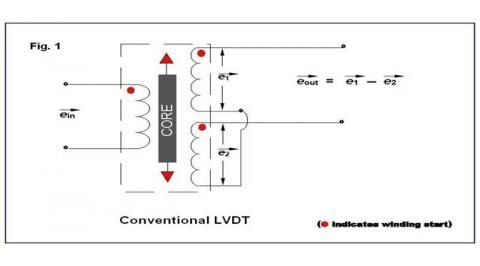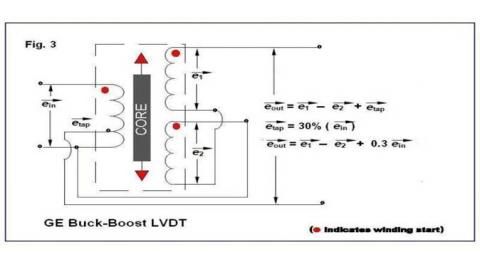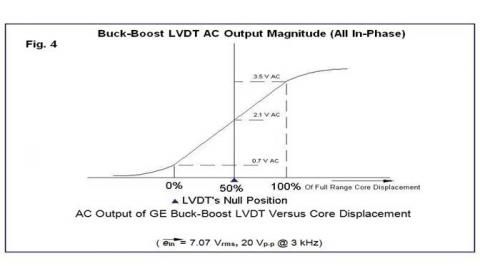How to use GE position sensors with third-party LVDT signal conditioners - I
LVDTs (Linear Variable Differential Transformers) are very commonly used as position sensors in power plants throughout the world. Working from AC voltages and frequencies not available from power lines, LVDTs require a signal conditioner to provide the necessary operating power. Alliance Sensors Group's model S1A module is a single channel LVDT signal conditioner on the market today. It can operate practically any inductive or LVDT-type position sensor currently in use.
However, users and systems integrators can be confused by unusual LVDT configurations, particularly in regard to the General Electric 185A1328 and 311A5178 series of LVDTs typically used with their gas turbines. Furthermore, for many years, GE has been using a contactless position sensor known as an inductive half-bridge for measuring the position of the operating shafts of steam turbine control valves.
These sensors, often called VRTs or LVRTs, are used to provide position feedback from modulating throttle and governor valves, as well as to give open or closed condition feedback from bypass, stop, and interceptor valves. They are also used to monitor valve position on some turbine feedwater pumps. Some typical GE half-bridge part numbers include the 119C9638, 119C9639, and 196C8768 series.
Again, there is some confusion among many systems integrators about how to connect these GE half-bridge sensors to an LVDT signal conditioner and how to calibrate them. This article should dispel much of the confusion around the operation of both GE gas turbine LVDTs and inductive half-bridge sensors.
Operating GE Gas Turbine LVDTs with an ASG S1A LVDT Signal Conditioner
The first section of this article shows how these GE LVDTs differ from conventional LVDTs, and how to operate them with an S1A LVDT signal conditioner module. To understand the differences between GE Gas Turbine LVDTs and conventional LVDTs, it is important to review the characteristics of an ordinary LVDT. Regardless of the method of construction actually used to make a conventional LVDT, it has a primary winding and two identical secondary windings that are usually connected in series opposition, with a movable permeable core to couple the primary to the secondaries, as shown in Figure 1 below.

The electrical output of a typical LVDT as a function of its core's position is shown in Figure 2 below. Note that the plot of its AC output amplitude versus position shows the classical "V" shape usually associated with an LVDT, with a minimum value called null at the center of its range of motion, and an increased output amplitude for core positions on either side of null.

More important is the fact that the phase relationship of the differential AC output to the primary input voltage shifts abruptly by 180° as the core moves through null. It is this 180° phase shift that permits a user to know on which side of null the core is positioned. The voltages and frequency shown are typical of those found in the operation of a conventional LVDT.
It is important to note that the actual excitation voltage utilized makes very little difference to an LVDT's performance. Only the excitation frequency is important for proper operation.
The configuration of the LVDTs used by GE for various position sensing functions on their gas turbines is shown in Figure 3 below.

The most obvious difference is the tap on the primary, but otherwise it does not seem to vary much from the view of a conventional LVDT. Howe
ver, its electrical operation is really substantially different. Although it is tempting to view the primary tap as a center tap, it is not a center tap at all. Most often it is a 30% tap, but on a few models it is a 25% tap. The voltages shown are typical of those used by GE, but, as noted above, the sensor is a differential transformer and will function with whatever AC voltage is applied to operate it. For the sake of clarity, typical GE I/O values are used for the explanation of how this variety of LVDT works.
This LVDT hookup is generally known as a "Buck-Boost" configuration. As can be seen in Figure 3, the voltage at the tap is 30% of the excitation voltage that is being applied to the LVDTs primary, and is in phase with the primary voltage. The way the windings are connected, this 30% voltage, e tap, is being added to the differential secondary voltage, which consists of e1, which is in phase with the primary voltage, to which has been added e2, which is 180
°
out of phase with the primary voltage.
The turns ratio of these GE LVDTs is usually about 5:1, so, with a 7.07 V ACrms input, the full scale output of the secondaries, without the effect of the 30% tap, would be about 1.4 V ACrms, either in phase with the primary excitation or 180° out of phase with it. However, the 30% tap inserts an additional 2.1 V ACrms that is in phase with the primary excitation to be added to the voltages already in the secondaries.

The result is plotted in Figure 4, which shows that the total AC output from the series connection of the two secondaries and the 30% tap is a voltage between 0.7 to 3.5 V ACrms, with no 180
°
phase shift as the LVDT's core moves from one end of its range of motion through null to the other end of its range.
The electronics used by GE in their controllers requires this unusual AC output, but almost all these "Buck-Boost" LVDTs can be successfully operated with an ASG S1A signal conditioner module by using the appropriate connection configuration. The first thing to do is to ignore any connection to the primary tap. Instead, connect the LVDT in a 3-wire configuration as shown in the S1A instruction manual. In this configuration, the high end of the primary is connected to J1-1, the common connection of the primary and the series-connected secondaries is connected to J1-3, and secondaries' high output is connected to J1-4.
A 3-wire configuration of an S1A applies only 1/2 of the usual input voltage to the primary, so it is good practice to shift jumper J7 over to its high output position to increase the excitation to the LVDT's primary by 50%. After this 3-wire connection for a "Buck-Boost" LVDT has been completed, the S1A can be operated, and the LVDT calibrated, in the normal manner shown in the S1A module's manual.
In the next part of this series, the author discusses how GE half-bridge sensors function, and how they can be used with an S1A signal conditioner.
(Ed Herceg is Chief Technology Office at Alliance Sensors Group of Moorestown, NJ. For more information, 856-727-0250, jrm@alliancesensors.com or visit www.alliancesensors.com)